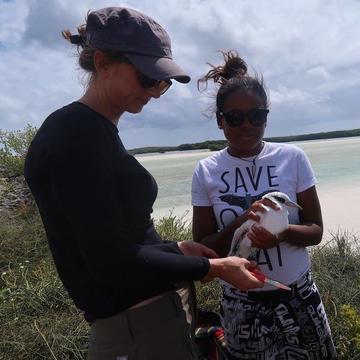New research from The University of Oxford, in collaboration with the Seychelles Seabird Group and published in the journal Avian Conservation & Ecology, presents the first nationwide assessment of the white-tailed tropicbird population in the Seychelles.
Seychelles supports the greatest abundance of seabirds in the tropical Indian Ocean, but regional seabird population breeding success and trend data are not readily available despite data collection spanning many years at several locations. The new paper brings together different datasets used to monitor five key nesting sites of white-tailed tropicbirds.

Researchers making observations of a juvenile white-tailed tropicbird
White-tailed tropicbirds spend most of their life over the open ocean and carry out long foraging trips. They mainly feed on surface-dwelling prey, such as flying fish and squid. When their food is scarce, their population numbers and breeding success can be rapidly affected. White-tailed tropicbirds breed on the ground in islands like the Seychelles, and are at risk from changes to their environment resulting from bad weather and invasive species like rats. White-tailed tropicbirds can also indicate broader changes in the birds’ environment. This is why bringing together different population and breeding data is a potentially valuable tool for managers of marine ecosystems.
To bring together these different types of information about the birds, the researchers analysed data from five islands in the Seychelles. Each island differs in size, geographical complexity, height, management strategy, and threat from predators and invasive species. The researchers visited white-tailed tropicbird nesting sites on the five islands, and followed what happened to nests and chicks. They measured size of the breeding population and the breeding success of adults (the percentage of nests that managed to rear a chick).
Overall, they found that average annual breeding success was lowest (15%) for Aldabra Atoll, which is the only one with invasive species such as rats and cats. Breeding success was much higher (33–55%) in the inner islands (Aride, Cousine, Denis, and Cousin). However, in the inner islands white-tailed tropicbirds show signs of potential population declines despite having stable and comparatively high breeding success. This contrasts with Aldabra where nesting activity has been relatively stable, but a decline in breeding success is causing concern.
The authors propose the adoption of standardised monitoring programmes and increased site coverage across Seychelles and the broader Western Indian Ocean. They believe this, coupled with increased pooling of data and regular analysis, will strengthen the collective effort towards the conservation management of this and other seabird species within this global seabird hotspot.
"This study demonstrates the great benefit of collaborative multi-site research, monitoring and analysis; by joining forces we were able to do more with fewer resources than if we had all worked separately” – April Burt.
To read more about this research, published in the Avian Conservation & Ecology, please visit https://www.ace-eco.org/vol16/iss2/art28/.